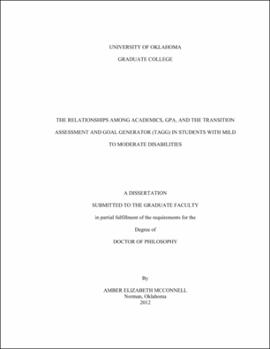| dc.contributor.advisor | Martin, James E | |
| dc.creator | McConnell, Amber Elizabeth | |
| dc.date.accessioned | 2019-04-27T21:24:07Z | |
| dc.date.available | 2019-04-27T21:24:07Z | |
| dc.date.issued | 2012 | |
| dc.identifier | 99156070902042 | |
| dc.identifier.uri | https://hdl.handle.net/11244/318591 | |
| dc.description.abstract | A nationwide push for students with disabilities to receive instruction in the general education classroom has stemmed, in part, from current legislation and high stakes testing. Student GPA continues to be a major factor in admission standards for postsecondary schools and initial employment opportunities. The focus on receiving instruction in the general education classroom and increasing student GPA may have unintended consequences for students with disabilities. Simply placing students in the general education setting and raising grades may not adequately prepare students with disabilities for life after high school. This study provides discriminate evidence of validity based on relations to other variables for a developing new transition assessment. Test developers used current literature that identified non-academic behaviors known to impact post-school success of students with disabilities to construct the Transition Assessment and Goal Generator (TAGG). The initial version of the TAGG consists of 75 items across ten domains and is offered in three parallel versions, professional, family member, and student. This study sought to determine if relations existed between the percent of time students with disabilities received instruction in the general education classroom and student GPA with TAGG scores provided by educators, family members, and students. Total TAGG scores provided by educators yielded weak statistically significant correlations with both percent of time students received instruction in the general education setting (r = .136, p < .05) and student GPA (r = .199, p < .05). Total scores provided by family members and students did not yield statistically significant correlations. This suggests that the TAGG measures behaviors different from those represented by GPA and educational placement. Students with disabilities who receive instruction in the general education setting and have higher GPAs may not automatically acquire the nonacademic skills and behaviors known to impact success after high school. A need remains for a research-based transition assessment to provide educators with possible annual transition goals to improve the likelihood of post-school success for students with disabilities. Implications for practice and future research needed are also discussed. | |
| dc.format.extent | 217 pages | |
| dc.format.medium | application.pdf | |
| dc.language | en_US | |
| dc.relation.requires | Adobe Acrobat Reader | |
| dc.subject | School-to-work transition--Evaluation | |
| dc.subject | Teenagers with disabilities--Vocational education--Evaluation | |
| dc.subject | Teenagers with disabilities--Psychological testing | |
| dc.subject | Vocational evaluation | |
| dc.title | The Relationships Among Academics, GPA, and the Transition Assessment and Goal Generator (TAGG) in Students with Mild to Moderate Disabilities | |
| dc.type | text | |
| dc.type | document | |
| dc.thesis.degree | Ph.D. | |
| ou.group | Jeannine Rainbolt College of Education::Department of Educational Psychology | |
